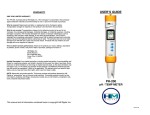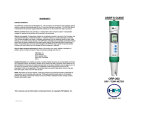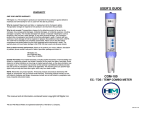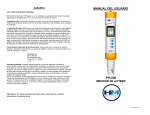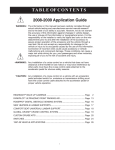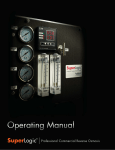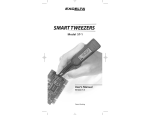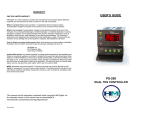Download USER'S GUIDE PH-200
Transcript
WARRANTY
USER’S GUIDE
ONE YEAR LIMITED WARRANTY
The PH-200, manufactured by HM Digital, Inc. ("the Company") is warranted to the purchaser
against defective materials and workmanship for one (1) year from the date of purchase.
What is covered: Repair parts and labor, or replacement at the Company's option.
Transportation charges for repaired of new product to be returned to the purchaser.
What is not covered: Transportation charges for the defective product to be sent to the
Company. Any consequential damages, incidental damages, or incidental expenses, including
damages to property. This includes damages from abuse or improper maintenance such as
tampering, wear and tear, water damage, or any other physical damage. The Company's
products are not waterproof and should not be fully submerged in water. Products with any
evidence of such damage will not be repaired or replaced. See additional note below. (NOTE The PH-200 is watertight and completely submersible. Please ensure that the battery
compartment and probe gasket ring are firmly tightened before submersing in water. The
warranty does not cover water damage to the PH-200 due to parts not securely closed.)
How to obtain warranty performance: Attach to the product your name, address, description
of problem, phone number, and proof of date of purchase, package and return to:
HM Digital, Inc.
5819 Uplander Way
Culver City, CA 90230
Implied Warranties: Any implied warranties, including implied warranties of merchantability and
fitness for a particular purpose, are limited in duration to five years from date of purchase. Some
states do not allow limitations on how long an implied warranty lasts, so the above limitation may
not apply to you. To the extent any provision of this warranty is prohibited by federal and state
law and cannot be preempted, it shall not be applicable. This warranty gives you specific legal
rights, and you may also have other rights, which vary from state to state.
NOTE: Warranties are product-specific. Third-party products and products deemed by HM
Digital as "accessories" are not covered under warranty. Third-party products include, but are
not limited to, batteries and fittings. Accessories include, but are not limited to, precipitator rods,
fuses, lanyards and product cases.
PH-200
pH / TEMP METER
This manual and all information contained herein is copyright HM Digital, Inc.
PH-200 1/06
Changing the batteries:
CONTENTS
Overview……………………………………………………………. 1
Contact Information………………………………………………...1
Specifications………………………………………………………. 1
Housing and Screen Description………………………………… 2
Taking Measurements…………………………………………….. 3
Calibration………………………………………………………….. 4
Care, Maintenance & Techniques………………………...…….. 5
Warranty……………………………………………………………. 7
When the meter displays a flashing battery symbol, your batteries
are getting weak and should be replaced soon. To change the
batteries:
1. Twist open the battery compartment on the top of the meter.
2. Remove the three batteries.
3. Insert new batteries in the direction as depicted inside the
compartment. The meter uses 357A batteries.
4. Close the battery compartment. Make sure it is tightly closed to
retain waterproofness.
OVERVIEW
NOTE: Do not reverse the polarity of the batteries. This will short circuit the meter.
Thank you for purchasing HM Digital’s PH-200 Meter. The PH-200 is an advanced handheld,
watertight pH meter with superior accuracy. It can be used for testing the acidity or alkaline
levels of almost any liquid, in a wide variety of applications, provided the liquid contains less than
50% alcohol. It also measure temperature in both Celsius and Fahrenheit. The meter
incorporates automatic temperature compensation (ATC) to accommodate for discrepancies in
temperature that would naturally occur. Though the meter is factory calibrated, it also features
digital calibration for easy and precise calibration that will yield better results.
Cleaning and sensor care:
1. Never touch the sensor!
2. To clean the unit, use a soft rag or towel. Wipe with water and a mild soap or rubbing alcohol.
3. To clean the sensor, rinse in distilled water or a pH 7 buffer solution. If cleaning with a pH 7
buffer solution, lightly dab (touch) the sensor on a soft tissue. Never rub the sensor with a tissue
or anything else, as this may scratch the glass.
4. If it is found that the glass sensor is scratched, it needs to be replaced.
5. If the sensor is dried up (or the gel within it), you can attempt to re-moisten the sensor by
keeping it in distilled water or a pH 7 solution for at least two hours. If the meter still does not
function properly or accuracy is not at optimum performance, the sensor may be irreparably
damaged and must be replaced.
6. For best results, clean the sensor after each use, especially with very low or very high pH
liquids or liquids other than water.
Sensor Replacement:
pH Range: 0.00 – 14.0 pH
Temperature Range: 0-80 °C; 32-176 °F
Resolution:
pH: 0.01 pH
Temperature: .1 °C/F
Accuracy: +/- 0.02 pH
Temperature Compensation: Automatic (ATC) to 25 °C
Calibration: Auto-ranging to 4, 7 or 10 pH with fine tune digital calibration by push button.
Auto Shut-Off: After 5 minutes
Probe: Glass sensor and glass reference tube (single junction)
Safe Operating Temperature: 0-80 °C; 32-176 °F (measuring in extreme temperatures is not
recommended)
Display: LCD panel
Housing: Waterproof (submersible); floats
Power source: 3 x 1.5V button cell batteries (included), model 357A
Battery Life: Approximately 100 hours of usage
Dimensions: 18.5 x 3.4 x 3.4 cm (7.3 x 1.3 x 1.3 inches)
Weight: 95 grams (3.35 ounces)
1
If your sensor has been damaged, you can purchase a new one without having to purchase a
new meter. To replace the sensor:
1. Remove the sensor gasket ring by twisting it counter-clockwise.
2. Gently pull the sensor off the unit.
3. Gently insert the new sensor into the unit. Be sure to align the grooves properly. Never force
the sensor into the unit!
4. Make sure the rubber ring is properly positioned on the sensor.
5. Screw the gasket ring back onto the unit by twisting it clockwise. Tighten.
Sponge Care:
1. Never add distilled or tap water to the sponge, as mildew or mold may form.
2. Rewet with a 4 pH KCl solution
6
PH-200 1/06
TAKING MEASUREMENTS
The PH-200 can take measurements of pH levels and temperature.
pH Measurements
1.
2.
3.
4.
5.
6.
7.
8.
Remove the cap.
Press the ‘ON/OFF’ button. The display will become active.
Dip the meter into the water sample, liquid or solution to be tested.
Lightly swirl the meter to ensure the removal of trapped air bubbles or electric
charges. Do not tap it against the glass.
The meter will display a reading almost immediately. Keep
the meter in the liquid until the reading stabilizes (approx. 30
seconds) for an accurate reading. NOTE – It is a normal
function of pH for the reading to fluctuate and not fully
stabilize.
To view the reading out of the liquid, quickly press the
‘HOLD/MODE’ button while the meter is in the liquid. This
will hold the reading on the screen. Quickly pressing the
‘HOLD/MODE’ button again will release it.
Press the ‘ON/OFF’ button to turn the meter off.
Shake any excess water off the meter and rinse with distilled
or de-ionized water. Put the cap back on.
CALIBRATION
Your PH-200 meter has been factory-calibrated to a 7.00 pH buffer solution. While this is
suitable for most applications, it may be necessary to recalibrate the meter for more accurate
results. Additionally, it should be noted that pH buffer solutions may vary amongst
manufacturers. For best results, the PH-200 should be recalibrated to a pH buffer solution that
suits your specific needs.
The PH-200 features 3-point auto-ranging calibration with digital fine tuning. The meter can be
calibrated to pH buffer solutions of 4, 7 or 10 pH. To recalibrate the meter:
1.
2.
3.
4.
5.
Temperature Measurements
The temperature reading is always displayed on the LCD panel during measurement mode, and
is shown simultaneously for pH readings. It is not shown when the meter is in calibration mode.
The default temperature reading for the meter is in Celsius.
1.
2.
3.
4.
5.
6.
7.
8.
Remove the cap.
Press the ‘ON/OFF’ button. The display will become active.
The temperature reading is always displayed on the LCD panel (except in calibration
mode), and is shown simultaneously for pH readings.
The default mode for temperature is Celsius. To change the temp mode, quickly
press the ‘TEMP/CAL’ button to switch from Celsius to Fahrenheit or vice-versa.
Dip the meter into the water sample or solution to be measured.
The temperature reading will change immediately (unless the solution is at room
temp). For very hot or cold liquids, the reading may take slightly longer to stabilize.
Press the ‘ON/OFF’ button to turn the meter off.
Shake any excess water off the meter and rinse with distilled or de-ionized water. Put
the cap back on.
6.
7.
Turn the meter on by pressing the ‘ON/OFF’ button. Note that the reading will
fluctuate when the meter is not submersed in a liquid. It will begin to stabilize once it
is in a pH buffer solution.
Dip the meter into a pH buffer solution of 4, 7 or 10 pH. Lightly stir the meter for
approximately 30 seconds. The reading will change during this time and may continue
to change slightly after 30 seconds. This is normal.
Press and hold the ‘TEMP/CAL’ button. The temperature display will change to a
‘CAL’ image.
The meter will automatically adjust to a reading
within a range of the solution the meter is in.
Change the reading so that it matches the
calibration solution. For example, if your
calibration solution is 4 pH, decrease or
increase the reading until it reads ‘4.00’. To
increase the reading, press the ‘UP’ button
(TEMP/CAL). To decrease the reading, press
the ‘DOWN’ button (HOLD).
- If the calibration reading reaches the
minimum or maximum level within the
range (approx. +/- .5 pH), the screen will
display the ‘minimum calibration reached’
icon or ‘maximum calibration reached’
icon, respectively. Note that this occurs
only within the range of the sample the
meter is currently in. When ‘CAL’ does
not flash, it means calibration is in the
middle of the range.
To set the calibration, press and hold the
‘TEMP/CAL’ button until the screen reverts back to the measurement mode.
Your meter is now re-calibrated.
NOTE – The sensor is very sensitive. It is normal for the reading to change by .01 or .02.
NOTE – Because of the sensitivity of the pH sensor and reference tube, it is not recommended
to use your meter as a thermometer in very hot or very cold liquids.
Switching Temperature Modes:
The default temperature reading for the meter is in Celsius. To change the temperature mode,
quickly press the ‘TEMP/CAL’ button to switch from Celsius to Fahrenheit or from Fahrenheit to
Celsius.
3
4
PH-200 1/06
HOUSING AND SCREEN DESCRIPTION
CARE, MAINTENANCE & TECHNIQUES
As with all pH meters, the PH-200 requires proper maintenance to ensure a healthy lifespan for
the meter.
General techniques:
Housing
1. Do not store the unit in high temperature or direct sunlight.
2. Never touch the sensor! Skin oils may adversely affect the reading. If you do touch the
sensor, clean immediately with distilled water or a pH 7 buffer solution (see cleaning
instructions).
3. Always immediately replace the cap when the meter is not in use. The PH-200 cap contains a
small wetted sponge to ensure that the gel within the glass sensor does not dry up. NOTE – A
tightened cap will ensure a longer lifespan for your sensor!
4. Using the PH-200 in high temperature liquid, such as hot coffee, will shorten the lifespan of
the sensor. If testing in hot liquid is essential, be sure to not keep the meter in the hot liquid very
long. (Room temperature coffee will not adversely affect the sensor.)
5. After repeated usage in high TDS liquids, it is advised to clean the sensor to prevent residue
build-up.
6. If testing two samples over a wide range (e.g., pH 3 and pH 10), make sure to rinse the
sensor in distilled water or a pH 7 buffer solution between and after tests.
7. For optimum performance, it is best to use the meter at least once per month.
1.
2.
3.
4.
5.
6.
7.
8.
9.
Lanyard hook
Battery compartment
LCD display
Button panel
Power button
Calibration mode, temperature
mode, calibration-up button
Hold, calibration-down button
Sensor gasket ring
Detachable sensor (electrode)
For best measurement accuracy:
1. Though it is not necessary, the PH-200 will be more accurate if calibrated before each use.
This is the case with all digital pH meters.
2. Clean with distilled water or a pH 7 buffer solution after each use, even if checking the same
sample.
3. If an air bubble is lodged in the sensor, dip the meter in distilled water and stir. Remove the
meter and shake excess water off.
4. If the sensor is scratched, it must be replaced.
5. If the readings seem to slow down and continue to get slower, or the meter seems to have
become unresponsive or sluggish, you may need to change the batteries or replace the sensor.
Lifespans of sensors are limited. Lifespans vary depending upon usage. It is normal for a
sensor to wear out.
LCD Display
1.
2.
3.
4.
5.
Low battery indicator
pH measurement
Temperature measurement
Celsius/Fahrenheit mode
Hold mode
FOR ADVANCED USERS ONLY: If the meter is continuously used to check widely varying pH
levels and is also continuously recalibrated at different levels, performance may be affected. If
you find your meter is not be working at optimum performance, press and hold the ‘TEMP/CAL’
button. Once ‘CAL’ is flashing on the screen, press and hold both the ‘TEMP/CAL’ and ‘HOLD’
buttons at the same time for two seconds. This will reset the calibration. It is then necessary to
recalibrate the meter (see the Calibration chapter for more information).
2
5
PH-200 1/06




